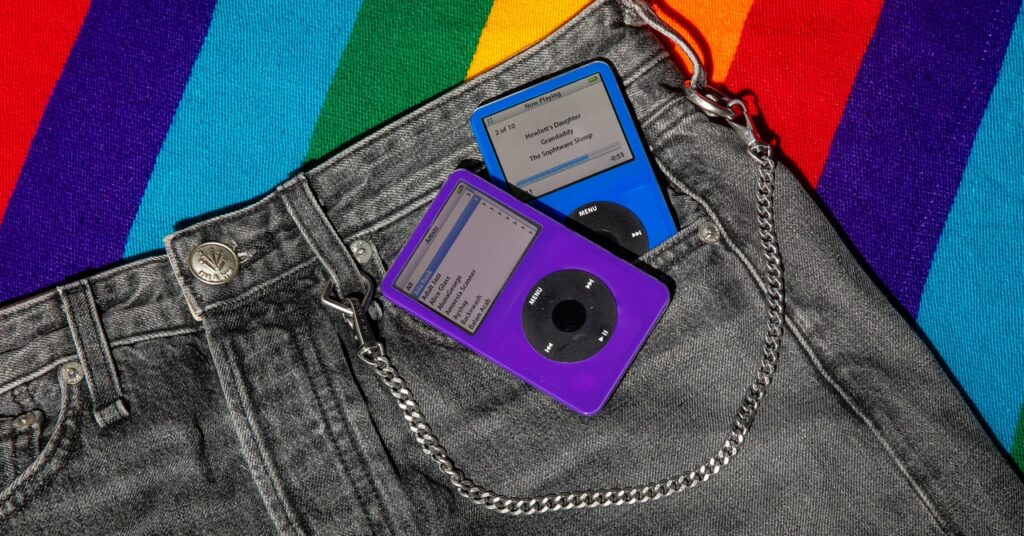iPod Modders Give Apple’s Abandoned Music Player New Life
By modifying old hardware with modern—and often more colorful—components, listeners create their dream iPods and kick their Spotify habits….


On Tuesday, September 9, 2014, Apple finally killed off the iPod. After almost 13 years on the market, the iconic portable music player was retired without fanfare. The pocket-sized device with the click wheel and a small color display simply disappeared from Apple’s online storefront just as the products that were announced that day—the Apple Watch and the iPhone 6—were being added.
Soon thereafter, reports circulated that new-in-box models of the last iPod bearing that original design—then called the “iPod Classic”—were selling on internet auction sites for at least double the retail price. Clearly, some people were not ready to face up to a future that felt inevitable: a move away from vast collections of MP3 files stored on dedicated music players and toward a world of streaming music delivered over the air for a $10 monthly fee.
Six years later, in 2021, Apple let the 20th anniversary of the iPod pass as quietly as it had let the iPod Classic fade into obscurity. Fans of the iPod, on the other hand, have been growing in number as vintage players are dusted off, repaired, and upgraded with new parts. Groups of hardware modders are adding things like Bluetooth capability, Taptic Engine feedback, custom colored cases, and terabytes of silent, power-sipping flash storage to their iPods, bringing the device fully into the 2020s—all without Apple’s blessing.
Kick Out the Jams
The original iPods were modular, breaking down into a screen, motherboard, headphone assembly, battery, and hard drive, all connected with tiny ribbon cables. With a bit of know-how, it’s now possible to add terabytes, not just gigabytes, into late-model iPods by swapping out the older spinning hard drive in favor of a newer solid state drive. Flash storage is more durable and more compact, uses less power, and gets rid of all the whirring and clicking typical of mechanical hard drives. And since SSDs are smaller, installing one frees up space inside the iPod’s case that hardware hackers can use to squeeze in additional niceties.
Reviving discarded gadgets is something the hardware hacking scene loves to do. By adopting the iPod platform, hackers turn e-waste into blank canvases for expression and symbols of rebellion against artist-unfriendly streaming services. Cara Esten, electronics enthusiast and musician, stumbled back into iPods after years of streaming music. “I ended up going to a garage sale, and somebody was selling a 30-gig iPod,” Esten says. “So I just picked it up. And I was like, there has to be a way to do a modern conversion … it just runs off of a pretty basic kind of standard interface.”
She cracked open her secondhand player and added flash storage, a new battery, and a shiny blue faceplate, making it immediately recognizable as better than the average ‘Pod. After reentering the iPod lifestyle with her reborn music player, she took to Twitter to post a simple manifesto promoting offline music listening:
Twitter content
This content can also be viewed on the site it originates from.
Esten says carrying an iPod with her is critical, especially when she loses data service on a commute that takes her into the cellular dead zone inside the train tunnel running beneath San Francisco Bay. “There were so many times I was listening to an album … I’d duck under the Transbay tunnel, completely lose signal, and it starts cutting out,” she says. “I think that’s the cool thing about the iPod. No matter what, [my music’s] there. I don’t want to have to make decisions about what I’m listening to beforehand. My phone could be dead, Spotify could be down. Knowing I can just put headphones on and listen to my music is so nice.”
Career Opportunities
College dropout Austin Lucas noticed something while working at a small-town mobile phone repair shop. A lot of customers were coming in with iPods that the shop—which had long since adjusted its business to meet the demands of the iPhone era—was no longer equipped to fix.
“Someone came in with a [seventh-gen iPod Classic] and my coworker was like ‘I don’t want to touch it.’ It clicked that every day, hundreds, if not thousands of people are going to repair shops with iPods and they’re being turned down. They’re being told it’s easier to go buy one online somewhere.”
That’s when he saw his opportunity. Quitting the phone biz, he started a shop with a focus on iPods, called Elite Obsolete Electronics. Since 2019, EOE has had a front-row seat to the iPod renaissance. In his Kansas lab, Lucas parts out iPods bought in bulk from electronics recyclers, tests the various bits, and reassembles working iPods with a mix of new and used components.




